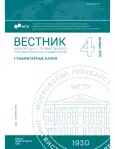Onomatopoeia Throughout Time
- Авторлар: Golubkova E.E.1,2
-
Мекемелер:
- Moscow State Linguistic University
- Financial University under the Government of the Russian Federation
- Шығарылым: № 4(898) (2025)
- Беттер: 33-41
- Бөлім: Linguistics
- URL: https://journal-vniispk.ru/2542-2197/article/view/291866
- ID: 291866
Дәйексөз келтіру
Толық мәтін
Аннотация
The article explores the tendencies in the system of contemporary onomatopes relying on the methodology of frame analysis. It is aimed at investigating the dynamics in the system of onomatopoetic words and sound symbolism in English and Russian. The study is based on forums and social media, as well on as corpora of the two languages. It unveiled that onomatopoeic words exhibit a dynamic semantic nature, with the potential to acquire new meanings and connotations over time, particularly in multimodal discourse. Languages showcase varying frequencies and types of onomatopoeia based on their word-building mechanisms. It was observed that onomatopes often retain a connection to the original sound they imitate, forming a crucial element that influences the evolving meanings of these words.
Негізгі сөздер
Авторлар туралы
Ekaterina Golubkova
Moscow State Linguistic University; Financial University under the Government of the Russian Federation
Хат алмасуға жауапты Автор.
Email: katemg@yandex.ru
Doctor of Philology (Dr. habil.), Professor, Professor at the Department of English lexicology of the Faculty of the English language, Moscow State Linguistic University, Professor at the Department of Foreign Languages and Intercultural Communication, Faculty of International Economic Relationship, Financial University under the Government of the Russian Federation
РесейӘдебиет тізімі
- Alieva, S. A. (2009). Onomatopes in multi-system languages: structural and semantic description. Bulletin of the Russian State Pedagogical University, named after A. I. Hertsen, 110, 126–132.
- Krivosheeva, E. I. (2014). The study of iconicity in sound imitations (based on Japanese and Russian). PhD thesis in Philology. Kemerovo. (In Russ.)
- Alkenova, S. N. (2021). Conceptual Domains of Onomatopoetic Words in the English language. Phylological sciences. The issues of theory and practice, 14-7, 2113–2117.
- Semenova, M. O. (2024). Allusions and other manifestations of intertextuality in the localization of games. Vestnik of Moscow State Linguistic University. Humanities, 11(892), 90–96. (In Russ).
- Motamedi, Y., et al. (2021). Linking language to sensory experience: onomatopoeia in early language development. Developmental Science, 24(3). 10.1111/desc.13066.
- Laili, N., Putri, F. (2021). Phonological Study of Onomatopoeia in Children’s Song. Journal of English Language Teaching and Linguistics, 6(1), 211–224.
- Tiara, E. (2013). An Analysis of Onomatopoeias In Garfield Comic. Vivid: Journal of Language and Literature, 2(2). https://doi.org/10.25077/vj.2.2.%25p.2013.
- Sychev, A. M., Potaenko, T. D., Kapitonova, N. S. (2021). Features of onomatopoeia (onomatopoeia) on the example of Spanish and English fiction. International Journal of Advanced Studies in Language and Communication, 1, 32–37. (In Russ.)
- Levin, M., Maricic, I. (2010). Onomatopoeic phrasal verbs: a corpus study of their meanings and usage in American English. Lund University: Centre for Languages and Literature.
- Rakhilina, E. V., Reznikova, T. I., Orekhov, B. (2015). And oinked the zeluks: preliminary remarks on the verbs of animal sounds and their semantics. Verbs of animal sounds: typology of metaphorical extensions (pp. 9–37). Moscow: Languages of Slavic Cultures.
- Fillmore, C., Baker, C. (2009). A frames approach to semantic analysis. In Heine, B., Narrog, H. (Eds.), The Oxford handbook of linguistic analysis (pp. 313–340). Oxford: Oxford University Press.
- Neumair, P. A., Gehrecke, F. M., Hartmann, S., Ziem, A. (2025). A frame-semantic approach to conceptual metaphors in the domain of emotion. Language and Cognition (pp. 1–18). Cambridge University Press.
- Gouseva, O. A., Popova, E. A. (2020). Laughter in Russian and English internet-communication. Vestnik of Moscow State Linguistic University. Humanities, 6(835), 33–46. (In Russ).
- Voronin, S. V. (2004). English onomatopes: phonosemantic classification. 2nd edition. St.Petersburg: Gelikon Plus. (In Russ.)
- Nurullova, A. A. (2013). Onomatopeia in modern English, Russian and German: PhD thesis in Philology. Kazan. (In Russ.)
Қосымша файлдар










